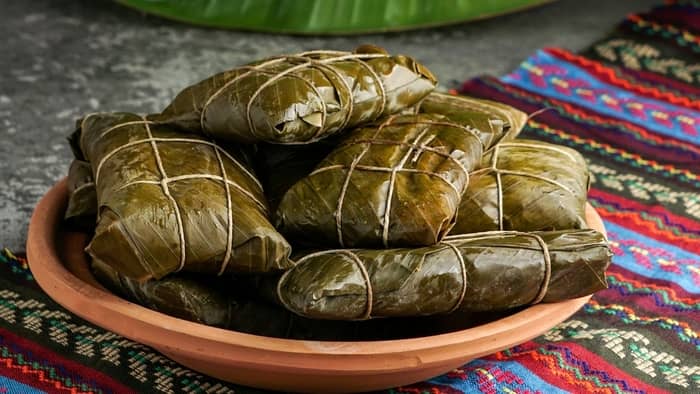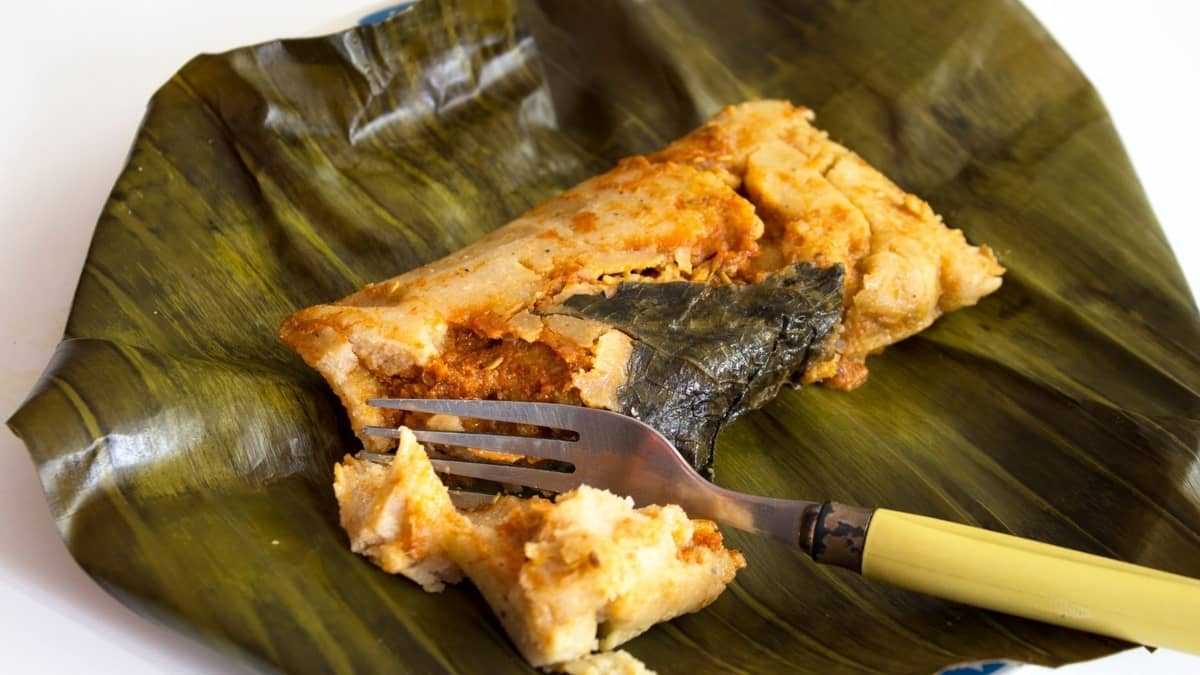Making tamales without corn husks is a quite popular way of enjoying tamales. Although corn husk has beat out other leaves in terms of preference, there are different routes that you can take to get different tastes.
Mexico is the world capital of tamales. For this reason, if you travel around this illustrious country, and its neighbors, especially Southern Mexico and Central America, you can try literally hundreds of different types!
People used a variety of different coverings for tamales out of necessity because they simply didn’t have the containers to capture the water of the masa so that it could cook properly. Keep in mind that masa harina is made out of corn, which requires a lot of cooking to make it soft and edible.
So the peoples of Meso-America looked to their environment for support. They found that the leaves of nature worked quite well, not only to trap the heat and moisture but to give it a delicious flavoring as well.
In the South and South-Eastern regions of Mexico, the bank leaf is favored. In these parts of the country, the moisture favors the cultivation of banana trees. Also, this is where people use certain spices that give tamales a somewhat Asian taste. This can be explained by the fact that the Nao of China arrived in the coasts of Guerrero many centuries ago bringing not only products from Asia but also cultural practices that still prevail in this huge region.
Moreover, Banana leaves work very well with your choice of tamale wrapper alternatives, and especially with pork grease, as they don’t stick together as you will see if you follow this wonderful pork tamal recipe.
Table of Contents
Step by Step Instructions On How To Make Tamales With Banana Leaves

Ingredients
- 1 kg 400 grams of pork cut into squares
- 8 ancho chiles (other chiles can work out as well)
- 1 package of banana leaves
- 3 spoonfuls of ground black pepper
- 1 small onion
- 3 cloves of garlic
- 1 spoonful of cumin
- A clove of garlic
- 1 cup of water
For the mass
- 1 kg og Maseca
- 1 kg of lard
- 1 liter of water
- Salt
Equipment
- Large pot
- Blender
- Spoon
- Pan
- Bowls
- Cup
- Steamer
- Step 1: Wash the banano leaves
Wash the banano leaves and warm them up in hot water on a low heat until they are tender.
Step 2: Remove hard edge
Remove the hard edge of the leaves and cut them in squares.
Step 3: Cook Chile
Cook the ancho chile until it feels tender. Remove the seeds.
Step 4: Mix ingredients
Blend the ancho Chile, the garlic, the onion, cumin, salt, pepper, and the water.
Step 5: Add sauce
Add this sauce to the raw pork.
Step 6: Mix Maseca with lard
In a bowl, stir the cornflour Maseca with the lard. You need to mix it until you get a creamy and homogeneous paste.
Step 7: Mix with water
Gradually pour the water in the mix, and keep stirring. Add the salt. Knead the mix until the mass is spongy and soft.
Step 8: Fill banano leaves with mass
Place a square of banano leaves on the palm of your hand and put a bit of mass on it. Extend it on the surface of the leaves with the reverse of a spoon. You’ll do this until you feel that you get to the right size of your tamal.
Step 9: Add the pork
Add a little bit of the pork in the sauce and distribute it along the tamal. Then fold the tamal.
Step 10: Fold tamal
Folding this kind of tamal can be tricky. Firstly, you need to fold the lateral edges of the leaves into the center and then you fold the upper and the lower edges on the back of the teal. Repeat this procedure with all the tamales.
Step 11: Cook tamal
Place the tamale in a steamer. You need to cook them for one hour and a half.
Step 12: Serve
Serve on a plate with a fork.
Cooking Time and Servings
Preparation: 30 minutes
Cooking time: 2 hours and a half
Servings: 12 tamales
Tips and Tricks
People prefer Acuyo banana leaf as it gives tamales, especially those with pork, quite a delicious taste. Also, there are some people who prefer guajillo Chile instead of ancho Chile. This will work for you if you prefer a sweeter tamal. If you love spicy food, you can definitely use Chile de árbol, they are hot and will make your day!
There are a couple of tricks that you might find handy to know if the tamales mass is ready. You can spread the mass on the leaf with a spoon. If it extends easily and doesn’t get stuck on the spoon, you rest assured that it is ready.
Also, you can make a little ball with the mass and drop it in a glass of water. If it floats, it is ready. As you might imagine, it´s key to hit the right mark regarding your mass as it cannot be too creamy nor too stiff.
Conclusion
Tamales are delicious. Just because their texture is so unique, this shouldn’t intimidate you when it comes to making them in the comfort of your own kitchen. It’s a fun activity that the whole family can get involved in and look at it as an opportunity to learn about Mexican cuisine and its flavors.
The best meals are the most inventive. So this experience can really serve to broaden your horizons about what’s possible regarding your ideas about tamale corn husk substitute.
Mexican people usually enjoy their tamales at night with a strong coffee. However, there are many who love their tamales as breakfast. Keep in mind that tamales are a heavy meal as they have plenty of grease. So, they can work better in the morning than at night. If you eat them at night, rest assured: you won’t need to eat anymore.
This recipe is pretty easy to follow. If you like the way that it turns out for you, it’s sure to inspire you and your loved ones to try out other tamal recipes. Keep in mind that many of them, prevalent in several Central America Countries, follow many of the same principles.
Read more about How To Make Bionicos Cream The Easy Way

Tamales With Banana Leaves
Ingredients
Equipment
Method
- Wash the banano leaves and warm them up in hot water on a low heat until they are tender.
- Remove the hard edge of the leaves and cut them in squares.
- Cook the ancho chile until it feels tender. Remove the seeds.
- Blend the ancho Chile, the garlic, the onion, cumin, salt, pepper, and the water.
- Add this sauce to the raw pork.
- In a bowl, stir the cornflour Maseca with the lard. You need to mix it until you get a creamy and homogeneous paste.
- Gradually pour the water in the mix, and keep stirring. Add the salt. Knead the mix until the mass is spongy and soft.
- Place a square of banano leaves on the palm of your hand and put a bit of mass on it. Extend it on the surface of the leaves with the reverse of a spoon. You’ll do this until you feel that you get to the right size of your tamal.
- Add a little bit of the pork in the sauce and distribute it along the tamal. Then fold the tamal.
- Folding this kind of tamal can be tricky. Firstly, you need to fold the lateral edges of the leaves into the center and then you fold the upper and the lower edges on the back of the teal. Repeat this procedure with all the tamales.
- Place the tamale in a steamer. You need to cook them for one hour and a half.
- Serve on a plate with a fork.
Notes
Tips and Tricks
People prefer Acuyo banana leaf as it gives tamales, especially those with pork, quite a delicious taste. Also, there are some people who prefer guajillo Chile instead of ancho Chile. This will work for you if you prefer a sweeter tamal. If you love spicy food, you can definitely use Chile de árbol, they are hot and will make your day!
Maria is a passionate Mexican–American cook who loves to create delicious and authentic Mexican cuisine. She has been cooking since she was a young girl, learning traditional recipes from her grandmother. She loves to experiment with new flavors and to use local, seasonal ingredients whenever possible. She enjoys introducing her guests to the flavors of her culture and sharing stories of the history of Mexican cuisine. Maria takes great pride in her cooking and loves to see how her food brings people together. She is always looking for ways to make her dishes even more delicious and inviting.
